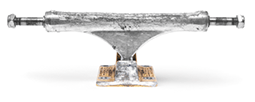Skateboarding Injuries & Physiotherapy: Part Two
- The Skateboarder's Companion

- Jul 14, 2023
- 7 min read
Consultation with Ben Rowles
Skateboarding Injuries and Physiotherapy: Part Two

Photo: Reece Leung.
Following on from Part One - where we talked about physiotherapy services, what to expect from a physio session, and how to get the best out of your rehab – we're now going to delve in to a few physio concepts that are aimed at helping you to get back to skating following an injury, while reducing the risk of re-injury.
Everything in this article is designed to be considered alongside any specific advice given to you by a doctor or physiotherapist, so if you missed our last article, then I'd suggest to give that a read first for info on how to get an appointment, enabling any individual needs to be discussed between you and a healthcare professional.
The question on every recovering skater's mind - 'when can I start skating again?'
Progressing Exercises.
This first topic is all about the importance of progressing exercises and consistent monitoring of your recovery. Here's a scenario - using my name - that is very common with skateboarding:
Ben obtains an ankle injury while skateboarding. He gets given some simple exercises from a physio or purchases an exercise band and begins basic strengthening exercises. A few weeks later, Ben’s ankle feels a little better so he starts skating again, but after a few months of continued strengthening exercises, his ankle does not feel 100% and his confidence when skating is low. This results in confusion as to why his ankle isn't feeling better despite doing the exercises, leaving Ben demoralised and demotivated. He stops doing the exercises altogether.
Often what is missed in situations like these is progression. How can we expect our bodies to get stronger and recover to the extent where we can confidently ride a skateboard again if we continue to stick with the same basic exercises that we began with at the start of an injury?
I would advise booking a follow up session after your initial appointment and ask your physiotherapist to show you more difficult exercises for when your original ones start to feel too easy. Keep on booking follow ups and progress to harder exercises under the guidance of the physio or doctor until you feel confident on your board again. Strengthening, balance and plyometrics (hopping) type exercises are particularly good for high impact activities like skateboarding, so keep these in mind when discussing progression with your physio.
It's important to consistently monitor how the body responds to prescribed exercises, and a great way to do this is to write down your symptoms after you've done the exercises and take your notes to your follow up sessions. Your physio can then advise whether the symptoms are okay, or whether the exercises need to be adapted.
Returning to Skating.
The question that's on every recovering skateboarder’s mind: “when can I start skating again?” I always answer by saying: “that depends on the individual”.
Type and severity of injury, individual stages of recovery, personal confidence levels and general lifestyle factors – these are just a few things that would be considered when contemplating a return to skating. I would always recommend having a good conversation with a physio or doctor regarding this topic, and to ask as many questions as you need to feel confident in your decision.
When you do start to return to skating, physically you probably won't feel 100% straight away. The injury might have left some lasting symptoms such as aches and pains that may take some time to go. Which brings me to the topic of: how to manage these symptoms while gradually returning to skating. It's one thing to manage symptoms like pain in the controlled environment of a physio session under close supervision of a healthcare professional, but it's a different concept if you're out skateboarding by yourself.
One question that I encourage people to ask themselves when returning to skating is: are my symptoms the same as the symptoms that I have already discussed with a healthcare professional, or are they new/different?
If they are the same, such as an aching ankle after 20 minutes of skating, then revisit the advice from your physio in regards to how much exercise and/or skating is appropriate for at this stage in the rehab process. If you've already had this type of discussion then it’s likely you’ve been informed about what should feel normal, and what may be an indication of pushing things too far. In this type of situation, your physio will possibly look at how to adapt the way you're skating to meet your rehab needs, and advise on how long to skate, how intensely, how regularly, and educate you about what types of symptoms are normal or abnormal to experience.
If the symptoms are new or different to the ones that you have already discussed, then these need to be treated as a brand new symptom or injury, which needs to be assessed by a qualified healthcare professional. See our previous article for more info on this.

Saul Crumlish teeters on a Transport nosepick. Photo: Leo Sharp.
Choosing an Additional Exercise.
Regardless of whether you normally skate every day, or once a month, it can be really difficult to keep motivated, and keep fit, when you can't skate because of an injury.
So how do we reap all the physical and mental health rewards that come with keeping active and social when we can’t skate? It can be useful to choose another type of exercise to do alongside physio rehab so that you can keep getting stronger and improving your exercise tolerance without relying solely on skating.
A physio can help you choose the right type of additional exercise, but here are a few types of common exercises that are easily accessible:
- Walking: cheap, simple, no extra equipment needed.
- Cycling: a great form of cardiovascular fitness while taking weight off an injured area, for example ankles and knees.
- Swimming: another great form of cardio fitness which is very light on joints.
- Running: accessible and cheap, however running can be demanding on joints, so may be something to consider in later stages of the recovery process.
- Gyms: great for quick access to different types of exercise, and while some people use them long term, others may prefer to use them with the short term aim of returning to skating.
All of these types of exercises can be made harder or easier by adapting speed, duration, and frequency. The most important element is finding some other form of exercise that you can rely on to stay active until you can get back to your normal skating routine.
Stay active until you can get back to your usual skating routine.
Prevention.
There comes a point in most people's rehab where their symptoms begin to feel a lot better and they start to feel more confident on their board again. This point is reached by being consistent with prescribed exercises, and having enough follow up sessions to complete the full course of physio. Exercises are often prescribed to be done daily, or every other day, until the person feels like they have achieved a recovery that they are happy with, but what happens after this? How long should you carry on with the exercises for?
One thing that I often see is people trying to continue at the same level of rehab after they are discharged from a physio. Here's my view on this:
Even when you can happily skate again, it's great to keep on top of fitness, especially following an injury where there is a risk of re-injury.
However, unless you have lots of spare time, it's unrealistic to expect yourself to do large amounts of daily exercises, and to sustain this long term. If you've gone through your rehab and are now looking at the injury prevention stage, we can consider the National Exercise Guidelines, as well as any individual needs. This can help to guide us when figuring out how often to keep doing physio exercises after the rehab stage has ended.
National Exercise Guidelines for adults (taken from Public Health England):
- 150 minutes of moderate intensity (a brisk walk) exercise per week, or…
- 75 minutes of vigorous intensity (running) exercise per week, plus…
- Strengthening exercises twice weekly.
In skateboard terms, these guidelines pretty much translate to: “go skateboarding regularly”, and if you can't fit in skating during the week as much as you would like, then consider adding in another type of exercise, as discussed above. Also, consider doing a form of strengthening exercises a few times per week. All of that combined should be a decent level of exercise for people to maintain fitness and, following an injury, maintain a good strength level that in turn can reduce the risk of re-injury. I'd suggest speaking to your physio about which exercises are best to continue with, that way you can focus on doing the most beneficial exercises a couple of times per week to keep you on point.
Lifestyle Factors.
On a final note, while most of what we have been talking about is related to injuries and how to use physical exercise to aid recovery, it's always helpful to consider a ‘whole person’ approach. Every healthcare professional is aware of this approach, however for those who use NHS services, you'll be aware of the difficult time constraints, which means there may not be much time within each session to discuss factors that aren't specifically related to the injury itself. For these reasons, it’s useful to be aware of other factors that can have an impact on injury recovery and general health, and to know where to look for self-help advice.
Here are some common areas that have the potential to impact on health when recovering from an injury:
Mental health, alcohol, smoking, drugs, diet, sleep, exercise, social surroundings, work/study and finances.
Simply having an awareness of these areas and the potential impact they could have on your health can assist you in seeking help when needed. If you do begin to struggle with any of these areas, a good starting point to seeking assistance is always a conversation with a doctor, healthcare professional, a trusted family member or friend. There are some great online resources out there that provide evidence based self-help tips on these common health topics, but for people who are in need more urgent support - for example, those who are struggling with mental health - there are the emergency services, and websites such as the NHS - www.nhs.uk - that have information about how to make contact with local support services.
My one tip to take away when searching for health advice online is: make sure that the information is coming from a reliable source. There is so much health advice online, and unfortunately a lot of it is not backed up by good quality evidence; some of it can be very misleading, and even dangerous. If you're not sure whether a website or social media channel is reliable, then just stick to known organisations such as the National Health Service (NHS), Public Health England (PHE), British Heart Foundation (BHF), British Lung Foundation (BLF), The Ben Raemers Foundation (BRF), The Samaritans, and British Dietetics Foundation (BDA) for diet advice.






Comments